You are using an out of date browser. It may not display this or other websites correctly.
You should upgrade or use an alternative browser.
You should upgrade or use an alternative browser.
enclosure for giant centipede?
- Thread starter alex_c
- Start date

Help Support Aussie Pythons & Snakes Forum:
This site may earn a commission from merchant affiliate
links, including eBay, Amazon, and others.
- Status
- Not open for further replies.
PhilK
Very Well-Known Member
How big will it get..? The Aussie pedes get to an upper limit of about 17cm. So twice that long, and about that wide. Make sure it can't reach the lid after addition of substrate
PhilK
Very Well-Known Member
As far as I know, bylo's 10cm long species will only grow to about 11 or 12cm, so they'll need an appropriate sized container if you want them to live happily. About twice as long, once as wide, and once as high plus a bit. Substrate should be deep enough to burrow. You can just keep them in deli containers etc but I don't like doing that with bigger ones.
I wrote a caresheet that is up on The Aussie Scorpion Website. I can PM the thing to you if you want?
I wrote a caresheet that is up on The Aussie Scorpion Website. I can PM the thing to you if you want?
yeah thanks that would be great. anyone know of anybody with larger pedes?As far as I know, bylo's 10cm long species will only grow to about 11 or 12cm, so they'll need an appropriate sized container if you want them to live happily. About twice as long, once as wide, and once as high plus a bit. Substrate should be deep enough to burrow. You can just keep them in deli containers etc but I don't like doing that with bigger ones.
I wrote a caresheet that is up on The Aussie Scorpion Website. I can PM the thing to you if you want?
PhilK
Very Well-Known Member
I had a 17cm long one that escaped. I'm about to come into some pedelings that should grow into the big species. PMing that caresheet now.
PhilK
Very Well-Known Member
Basics: Centipedes are 'Myriapods' (many legged arthropods). They are carnivorous and are very different to millipedes, who also belong in the same group. Telling the difference is quite easy: if you have a flattened myriapod, with mean looking pincers under the head, two longer 'terminal legs' ("ass feelers"), and one pair of legs per body segment you have a centipede. If your myriapod is more cylindrical, with two pairs of legs per body segment, you have a millipede.
A photo showing head of centipede. Note pincers under head.
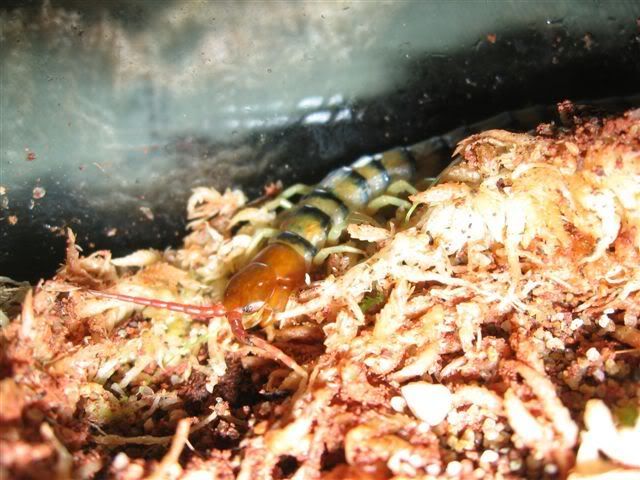
A (blurry) photo showing terminal legs of centipede. Absent from millipedes. They are against the left hand side of glass. Look like extra feelers.
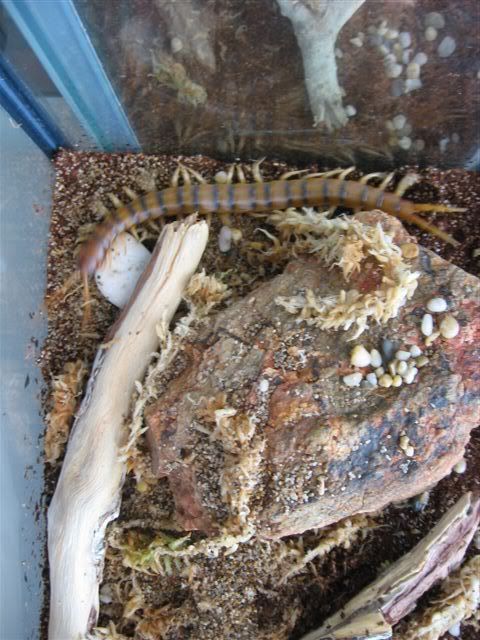
Housing: Centipedes can be housed in various different containers and tanks.
Pedelings: It is important to realise that pedelings are really quite small, so it is best to ensure that their housing is totally escape proof (i.e. they should not be kept in glass aquariums as they can easily scale the silicon in the corners). They are also more prone to dessication, and so careful attention must be paid to moisture levels. It is best to house pedelings in old (washed) Chinese food containers (or similair). These provide an escape proof, humid, stackable and rather small environment for the pedeling.
For substrate, make a mix of 50% cocopeat or similar and 50% sand. Make sure it is slightly damp, and pack it into the bottom of the container to a depth of about 4 or 5 cm (this is to allow burrowing. Can be deeper). If you wish, place a piece of bark, spahgnum moss, pebbles or a rock in the container for furniture. This is for aesthetics to the keeper and can be used as shelter for the pedeling (sphagnum moss is particularly good for this).
Ventilation can be an advantage, but can allow pedes to escape. When you get your pedelings, judge how big they are and whether you can safely add ventilation. If you can, heat an appropriate sized pin up (with a lighter) and put holes along one end of the lid of the container, as well as a few along the tops of the walls of the container. Do not do these all along. This allows a humid and a less humid environment to form. The pedeling can choose.
Bigger pedes: Once your pede is a little bigger, you can move it into a bigger enclosure, or can keep it where it is... Pedes do like to roam around and explore alot, so in my opinion, a bigger area is better (but understandably not always practical). A glass fish tank can function well, but any escape proof large container will suffice. Again, provide substrate (50/50 peat/sand mix) to a depth that allows burrowing if the pede wishes. Substrate should be damp, and packed down. Add furniture and decorations. I cannot stress enough that from personal experience, pedes are excellent escape artists and will escape from holes you never imagined (there's still a 17cm long, rather angry pede lurking in my room somewhere...) When moving the pede, do not handle it as they are very quick, very flighty and very painfully bitey. Try to change substrate totally once every month or two. (Store centipede in a mini-escape proof area during cleaning).
Humidity: If ventilation isn't very high, humidity should remain in the container well. But even so, sometimes a light misting can be beneficial. Mist once a week or so, and make sure to leave some droplets on the glass. The centipede will drink these droplets if it needs some free water.
Because the centipedes enclosure is so humid, and ventilation is usually low, try taking the lid off once a day and airing out for 45 seconds or so. Helps to get some fresh oxygen in there. Remember, your pede enclosure should not be saturated. 70 - 80% humidity should be OK.
A photo of the enclosure my pede is living in. This enclosure would be suitable right up to adult size. Note, too, different textures and furniture used.
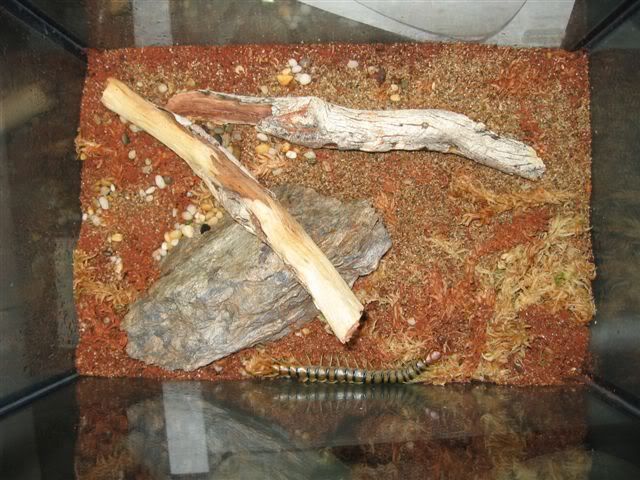
Food/Water: Centipedes are voracious predators and will eat almost anything big enough to overpower. This is suprisingly large. Centipedes detect food via their antennae primarily (to my understanding), and when they detect food, if they are hungry, will quickly strike and envenomate their prey item with their pincers (modified front legs positioned under their 'jaw'). They then proceed to feed at a suprisingly fast rate.
Pedelings: Pedelings, though small, are born with all the required attachments to hunt and kill. You can feed them live pinhead crickets if you wish, but seeing as pedelings seem to enjoy dying, many keepers opt to feed them prekilled pinheads instead. Because pedes are scavengers as well, they will happily eat a head-crushed mealworm, prekilled pinhead, chopped up adult, removed legs of adult etc etc. It's also been documented that they can and do eat fish-flakes. It's best not to feed them solely on flakes though. Vegetables sometimes are eaten too, as well as fruits like banana. A big meal (such as a mealworm) will easily last a pedeling a week. For pinheads 2-3 a week seems to be the way to go. Ensure that any uneaten food, whether live or dead, is removed from the pedeling's enclosure. For live prey, this should be done after 24 or 36 hours of it not being eaten, as it may attack your pedeling. For dead prey, remove it as soon as the pede is no longer interested as the humid environment will quickly encourage mould etc to grow.
Bigger pedes: Bigger pedes will eat a suprising range of prey, and seeing as they're bigger now they can be fed live prey of an appropriate size without too much worry. Mostly, adult and medium crickets/roaches etc (depending upon size of pede) is satisfactory. 2-3 a week seems the way to go, again. But make sure you remove any uneaten prey items after 24-36 hours in case of tables turning. Huge pedes can eat a frozen/thawed pinky rat once a month.. But that's just gross, so no thank you.. Imagine cleaning up after your messy pede? Some people feed their pedes solely on captured skinks and geckoes (for the love of God people, make sure it is an Asian House Gecko, not a native. If you don't know - don't do it). One only has to go to YouTube to see what pedes will eat. That being said I don't agree with the idea of feeding vertberates to centipedes.. it cannot be a pleasant death. Again, any leftover prey remains should be removed ASAP to prevent growth of mould/fungi.
Water: Centipedes are not usually supplied with a water dish. If you wish, you can use the lid off a jar of peanut butter for adults, or a small bottle cap for pedelings... The humidity in their enclosure and moisture in their prey should be plenty. They will occasionally drink droplets of moisture from the glass.
My pede feeding on a cricket. He could take a cricket bigger than this easily, but it was all I had.
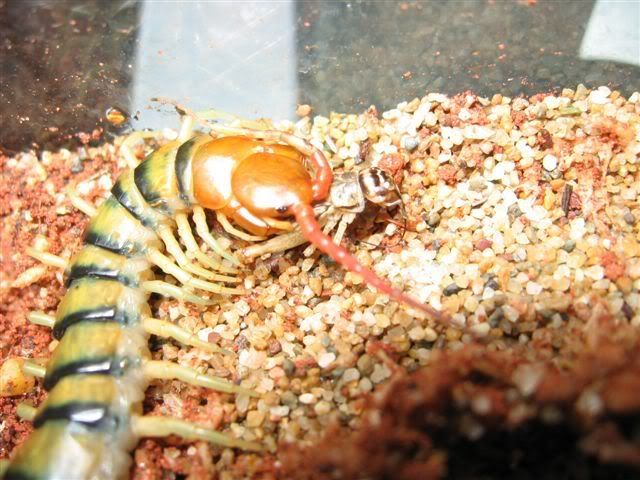
Growth: Centipedes (like scorpions and tarantulas) must periodically shed their exoskeletons to grow. They may burrow and disappear for a long time (this is normal behaviour, but may increase towards moult-time). Much of the time you won't see the moult happen as it will occur in the burrow. Even if it does occur on the surface, they often turn right around and eat their sheds to gain any nutrients, so you may not even notice they have shed. Coming up to a moult, ensure the humidity remains fairly high and remove any uneaten prey, as a moulting centipede is a vulnerable one (this is why we remove uneaten prey after a while). Mostly your centipede will moult fine by itself (they've been doing it for 10000s of years, after all) but occasionally a problem will arise.. Unfortunately there is very little you can do about these problems..
Breeding: Unfortunately I don't know very much about the breeding process other than many times, instead of sexing eachother up, the pedes end up eating eachother... Males spin a sperm 'web' and deposit a sperm sac. Female follows the male through and picks it up. Get the male out of there as quick as possible as she very quickly stops feeling romantic. She lays eggs and lies curled around them, cleaning them and guarding them in a 'basket' of her own legs. Don't disturb her now for any reason as she'll freak out and eat the eggs... Of course this happens occasionally anyway for no apparent reason. She'll often eat unfertile/damaged eggs. The eggs mature into little pedelings, and the pedelings stay with the mother for a while. She's very defensive and again will kill and eat any damaged/unhealthy pedelings. How to sex pedes? No idea...
There are plenty of wonderfully helpful sites on the net about pede breeding. Arachnoboards has a Myriapod section where there are many avid pede keepers.
Identification: ID'ing pedes is not easy, and I certainly don't have the foggiest. This link will help greatly. http://www.ento.csiro.au/biology/centipedes/centipedeKey.html
Miscellanious: Other things you might want to know.
Should I keep my pedes together? They have a huge tank.
No. No you shouldn't. You will soon only have one very full pede occupying that tank. They are vicious predators and will kill and eat eachother.
Where is my pede? I haven't seen it in ages. Should I dig it up?
If all conditions above are met, your pede should have no problems and so shouldn't be dead. Burrowing is natural behaviour (no birds can eat you if you're hidden away). They may be down there moulting or laying eggs. Best to leave them alone.
My pede is missing legs/feelers/is otherwise damaged..
There isn't much you can do to fix a serious injury in a pede. Missing limbs/feelers etc will be re-generated over the next few moults.
My pede escaped! Where is it?!
My pede escaped too. I still haven't found it, and it was 17cm long. Enough said.
Seriously though, escapee pedes gravitate to cool, dark, humid areas. Bathrooms and cupboards often provide this environment. Try leaving damp towels piled in corners of cupboards/other likely pede escape spots. They may go there for shelter. If not, try making mini 'pede houses'. Get an icecream container with lid. Stand it on the ground and cut a little door out of the bottom. Fill container with a bit of damp substrate, and put some dead crickets and some head-crushed mealworms in there along with somewhere to shelter. Put these traps around dark, cool, humid areas and leave overnight. Check in the morning. If these don't work, make sure you check your bed and covers every night before bed! Many escapees turn up months later, cruising the kitchen or something.
I hope this has helped you on your way to keeping these guys, as they are alot of fun!
Phil
The escapee:
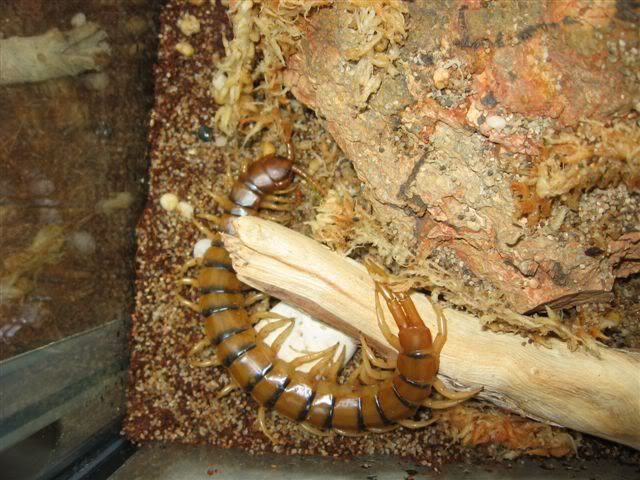
A photo showing head of centipede. Note pincers under head.

A (blurry) photo showing terminal legs of centipede. Absent from millipedes. They are against the left hand side of glass. Look like extra feelers.

Housing: Centipedes can be housed in various different containers and tanks.
Pedelings: It is important to realise that pedelings are really quite small, so it is best to ensure that their housing is totally escape proof (i.e. they should not be kept in glass aquariums as they can easily scale the silicon in the corners). They are also more prone to dessication, and so careful attention must be paid to moisture levels. It is best to house pedelings in old (washed) Chinese food containers (or similair). These provide an escape proof, humid, stackable and rather small environment for the pedeling.
For substrate, make a mix of 50% cocopeat or similar and 50% sand. Make sure it is slightly damp, and pack it into the bottom of the container to a depth of about 4 or 5 cm (this is to allow burrowing. Can be deeper). If you wish, place a piece of bark, spahgnum moss, pebbles or a rock in the container for furniture. This is for aesthetics to the keeper and can be used as shelter for the pedeling (sphagnum moss is particularly good for this).
Ventilation can be an advantage, but can allow pedes to escape. When you get your pedelings, judge how big they are and whether you can safely add ventilation. If you can, heat an appropriate sized pin up (with a lighter) and put holes along one end of the lid of the container, as well as a few along the tops of the walls of the container. Do not do these all along. This allows a humid and a less humid environment to form. The pedeling can choose.
Bigger pedes: Once your pede is a little bigger, you can move it into a bigger enclosure, or can keep it where it is... Pedes do like to roam around and explore alot, so in my opinion, a bigger area is better (but understandably not always practical). A glass fish tank can function well, but any escape proof large container will suffice. Again, provide substrate (50/50 peat/sand mix) to a depth that allows burrowing if the pede wishes. Substrate should be damp, and packed down. Add furniture and decorations. I cannot stress enough that from personal experience, pedes are excellent escape artists and will escape from holes you never imagined (there's still a 17cm long, rather angry pede lurking in my room somewhere...) When moving the pede, do not handle it as they are very quick, very flighty and very painfully bitey. Try to change substrate totally once every month or two. (Store centipede in a mini-escape proof area during cleaning).
Humidity: If ventilation isn't very high, humidity should remain in the container well. But even so, sometimes a light misting can be beneficial. Mist once a week or so, and make sure to leave some droplets on the glass. The centipede will drink these droplets if it needs some free water.
Because the centipedes enclosure is so humid, and ventilation is usually low, try taking the lid off once a day and airing out for 45 seconds or so. Helps to get some fresh oxygen in there. Remember, your pede enclosure should not be saturated. 70 - 80% humidity should be OK.
A photo of the enclosure my pede is living in. This enclosure would be suitable right up to adult size. Note, too, different textures and furniture used.

Food/Water: Centipedes are voracious predators and will eat almost anything big enough to overpower. This is suprisingly large. Centipedes detect food via their antennae primarily (to my understanding), and when they detect food, if they are hungry, will quickly strike and envenomate their prey item with their pincers (modified front legs positioned under their 'jaw'). They then proceed to feed at a suprisingly fast rate.
Pedelings: Pedelings, though small, are born with all the required attachments to hunt and kill. You can feed them live pinhead crickets if you wish, but seeing as pedelings seem to enjoy dying, many keepers opt to feed them prekilled pinheads instead. Because pedes are scavengers as well, they will happily eat a head-crushed mealworm, prekilled pinhead, chopped up adult, removed legs of adult etc etc. It's also been documented that they can and do eat fish-flakes. It's best not to feed them solely on flakes though. Vegetables sometimes are eaten too, as well as fruits like banana. A big meal (such as a mealworm) will easily last a pedeling a week. For pinheads 2-3 a week seems to be the way to go. Ensure that any uneaten food, whether live or dead, is removed from the pedeling's enclosure. For live prey, this should be done after 24 or 36 hours of it not being eaten, as it may attack your pedeling. For dead prey, remove it as soon as the pede is no longer interested as the humid environment will quickly encourage mould etc to grow.
Bigger pedes: Bigger pedes will eat a suprising range of prey, and seeing as they're bigger now they can be fed live prey of an appropriate size without too much worry. Mostly, adult and medium crickets/roaches etc (depending upon size of pede) is satisfactory. 2-3 a week seems the way to go, again. But make sure you remove any uneaten prey items after 24-36 hours in case of tables turning. Huge pedes can eat a frozen/thawed pinky rat once a month.. But that's just gross, so no thank you.. Imagine cleaning up after your messy pede? Some people feed their pedes solely on captured skinks and geckoes (for the love of God people, make sure it is an Asian House Gecko, not a native. If you don't know - don't do it). One only has to go to YouTube to see what pedes will eat. That being said I don't agree with the idea of feeding vertberates to centipedes.. it cannot be a pleasant death. Again, any leftover prey remains should be removed ASAP to prevent growth of mould/fungi.
Water: Centipedes are not usually supplied with a water dish. If you wish, you can use the lid off a jar of peanut butter for adults, or a small bottle cap for pedelings... The humidity in their enclosure and moisture in their prey should be plenty. They will occasionally drink droplets of moisture from the glass.
My pede feeding on a cricket. He could take a cricket bigger than this easily, but it was all I had.

Growth: Centipedes (like scorpions and tarantulas) must periodically shed their exoskeletons to grow. They may burrow and disappear for a long time (this is normal behaviour, but may increase towards moult-time). Much of the time you won't see the moult happen as it will occur in the burrow. Even if it does occur on the surface, they often turn right around and eat their sheds to gain any nutrients, so you may not even notice they have shed. Coming up to a moult, ensure the humidity remains fairly high and remove any uneaten prey, as a moulting centipede is a vulnerable one (this is why we remove uneaten prey after a while). Mostly your centipede will moult fine by itself (they've been doing it for 10000s of years, after all) but occasionally a problem will arise.. Unfortunately there is very little you can do about these problems..
Breeding: Unfortunately I don't know very much about the breeding process other than many times, instead of sexing eachother up, the pedes end up eating eachother... Males spin a sperm 'web' and deposit a sperm sac. Female follows the male through and picks it up. Get the male out of there as quick as possible as she very quickly stops feeling romantic. She lays eggs and lies curled around them, cleaning them and guarding them in a 'basket' of her own legs. Don't disturb her now for any reason as she'll freak out and eat the eggs... Of course this happens occasionally anyway for no apparent reason. She'll often eat unfertile/damaged eggs. The eggs mature into little pedelings, and the pedelings stay with the mother for a while. She's very defensive and again will kill and eat any damaged/unhealthy pedelings. How to sex pedes? No idea...
There are plenty of wonderfully helpful sites on the net about pede breeding. Arachnoboards has a Myriapod section where there are many avid pede keepers.
Identification: ID'ing pedes is not easy, and I certainly don't have the foggiest. This link will help greatly. http://www.ento.csiro.au/biology/centipedes/centipedeKey.html
Miscellanious: Other things you might want to know.
Should I keep my pedes together? They have a huge tank.
No. No you shouldn't. You will soon only have one very full pede occupying that tank. They are vicious predators and will kill and eat eachother.
Where is my pede? I haven't seen it in ages. Should I dig it up?
If all conditions above are met, your pede should have no problems and so shouldn't be dead. Burrowing is natural behaviour (no birds can eat you if you're hidden away). They may be down there moulting or laying eggs. Best to leave them alone.
My pede is missing legs/feelers/is otherwise damaged..
There isn't much you can do to fix a serious injury in a pede. Missing limbs/feelers etc will be re-generated over the next few moults.
My pede escaped! Where is it?!
My pede escaped too. I still haven't found it, and it was 17cm long. Enough said.
Seriously though, escapee pedes gravitate to cool, dark, humid areas. Bathrooms and cupboards often provide this environment. Try leaving damp towels piled in corners of cupboards/other likely pede escape spots. They may go there for shelter. If not, try making mini 'pede houses'. Get an icecream container with lid. Stand it on the ground and cut a little door out of the bottom. Fill container with a bit of damp substrate, and put some dead crickets and some head-crushed mealworms in there along with somewhere to shelter. Put these traps around dark, cool, humid areas and leave overnight. Check in the morning. If these don't work, make sure you check your bed and covers every night before bed! Many escapees turn up months later, cruising the kitchen or something.
I hope this has helped you on your way to keeping these guys, as they are alot of fun!
Phil
The escapee:

RevDaniel
Very Well-Known Member
- Joined
- Mar 27, 2005
- Messages
- 2,906
- Reaction score
- 0
yes, a big thankyou for that. After having caught a few with Brettix i have been thinking about keeping some. After reading your post i have decided thati will keep some. What kind os substrate do i use? Just normal dirt found in the area where the pede was collected?
Would it be a bad idea to swap them around to try breeding or must they be together until the sperm sack has been laid? I am finding these little guys most interesting.
My father put one in his mouth at age five thinking it was a lillypop. never did it again.
Would it be a bad idea to swap them around to try breeding or must they be together until the sperm sack has been laid? I am finding these little guys most interesting.
My father put one in his mouth at age five thinking it was a lillypop. never did it again.
RevDaniel
Very Well-Known Member
- Joined
- Mar 27, 2005
- Messages
- 2,906
- Reaction score
- 0
thanks. When we going herp hunting again Brettix? Will have to bring a few extra containers for them.
Inkslinger
Very Well-Known Member
Great info should be more of it
- Status
- Not open for further replies.
Similar threads
Lizards For Sale
Eastern Blue Tongue x 2 - Anstead, Brisbane
- Replies
- 1
- Views
- 283
- Replies
- 0
- Views
- 125
- Replies
- 2
- Views
- 1K
- Replies
- 6
- Views
- 269


